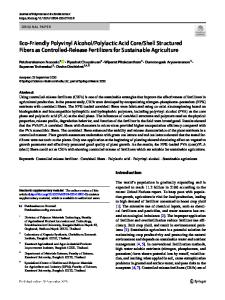Measuring the glass-transition temperature in electrospun polyvinyl alcohol fibers using AFM nanomechanical bending test
- PDF / 57,381 Bytes
- 5 Pages / 612 x 792 pts (letter) Page_size
- 76 Downloads / 375 Views
1185-II10-01
Measuring the glass-transition temperature in electrospun polyvinyl alcohol fibers using AFM nanomechanical bending tests Wei Wang1 and Asa H Barber1 1 Centre for Materials Research & School of Engineering and Materials Science, Queen Mary University of London, Mile End Road, London E1 4NS, UK. ABSTRACT The glass transition of individual electrospun PVA fibers was found using an AFM fiber bending technique within a heated chamber. A considerably loss in the measured elastic modulus was observed with temperature when the glass transition temperature was reached. The glass transition temperature was observed to decrease as the electrospun PVA fiber diameter decreased, indicating diameter dependent enhanced polymer chain mobility. INTRODUCTION Electrospinning is becoming a common method for the production of continuous polymer fibers [1]. The geometry of the resultant electrospun polymer fibers is critically linked to the electrospinning parameters [2]. In particular, the diameter of the spun fibers can be reduced to lengths approaching tens of nanometers but the effects of variation in size on physical properties has yet to be accurately determined. Understanding the variation of physical properties with fiber diameter needs to be accurately determined at a specific diameter but electrospinning does not produce fibers with mono-disperse diameters. Therefore, conventional techniques which require large amounts of electrospun fibers are insufficient as the corresponding properties over the range of fiber diameters will be examined. Some literature from our group [3] has recently examined the thermo-mechanical properties of electrospun polyethylene oxide fibers using atomic force microscopy (AFM). The advantage of this technique was to evaluate mechanical properties of individual electrospun fibers of a specific diameter and observe how the mechanical properties vary up to the melting temperature. In this work we extend the approach of nanomechanical testing to evaluate the glass transition temperature of electrospun polyvinyl alcohol (PV) fibers over a range of fiber diameters. EXPERIMENT Electrospinning was performed according to previous methods. Briefly, electrospinning introduces a polymer solution to a syringe with a metal needle tip. A voltage is applied between the syringe and a grounded collector substrate. The field strength at the end of the needle tip is considerably higher than in other regions within the syringe and, at a critical voltage, the build up of change within the solution causes repulsion within the solution and an expulsion of the solution from the syringe towards the collector. In this work, PVA (Sigma, UK, Mw= 85,000146,000) was dissolved in water at 80°C such that polymer solutions with a PVA wt/vol.% ranging from 6-13% could be prepared in order to spin fibers of different diameters. A polymer
film with thickness of many hundreds of microns was also cast from the same solution and is designated as a bulk sample. Fibers of PVA were electrospun at applied voltages of around 12kV
Data Loading...











